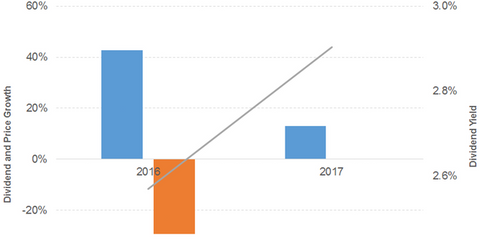These Factors Are Contributing to Gilead Sciences’ Weak Outlook
Gilead Sciences’ (GILD) revenue fell 7% and 13% in 2016 and 9M17, respectively. The fall was due to lower product sales. Both antiviral products and other products recorded declines in both the periods.
Jan. 15 2018, Updated 7:31 a.m. ET

What led to Gilead Sciences’ revenue decline?
Gilead Sciences’ (GILD) revenue fell 7% and 13% in 2016 and 9M17, respectively. The fall was due to lower product sales. Both antiviral products and other products recorded declines in both the periods. The US and Europe drove the decline in 2016, offset by Japan and other countries.
How much did the EPS fall?
Gross profit fell 9% and 14% in 2016 and 9M17, respectively. Operating expenses increased 32% in 2016 before decreasing 17% in 9M17. R&D expenses drove the costs higher in 2016 before falling in 9M17. As a result, income from operations dropped 21% and 13% in 2016 and 9M17, respectively. Adjusted income from operations fell 14% and 17% in 2016 and 9M17, respectively.
Higher interest expense was offset by higher other income in both the periods. Adjusted net income fell 18% and 23% in 2016 and 9M17, respectively. Diluted EPS dropped 8% and 20% in 2016 and 9M17, respectively. Share buybacks have enhanced the EPS numbers.
Dividend and price growth
Dividend per share grew 43% and 13% in 2016 and 2017, respectively. Prices lost 29% in 2016 and were flat in 2017, which explains the upward rising dividend yield curve. A forward PE of 8.2x and a dividend yield of 2.9% compares to a negative sector average forward PE of 3.7x and a dividend yield of 2.9%.
How does it compare to the broad indexes?
The S&P 500 (SPX-INDEX) (SPY) has a dividend yield of 2.2%, a PE ratio of 23.4x, and a YTD return of 19.6%. The Dow Jones Industrial Average (DJIA-INDEX) (DIA) has a dividend yield of 2.2%, a PE ratio of 22.3x, and a YTD return of 25.1%. The NASDAQ Composite (COMP-INDEX) (ONEQ) has a PE ratio of 28.2x and a YTD return of 24.8%.
What is the revenue and EPS outlook?
Gilead Sciences is projected to record a revenue decline of 15% and 14% in 2017 and 2018, respectively. The diluted EPS is projected to fall by 25% in 2017 and 22% in 2018.
